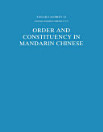Essays on Anaphora
H. Lasnik
ธ.ค. 2012 · Studies in Natural Language and Linguistic Theory หนังสือเล่มที่ 16 · Springer Science & Business Media
eBook
180
หน้า
reportคะแนนและรีวิวไม่ได้รับการตรวจสอบยืนยัน ดูข้อมูลเพิ่มเติม
เกี่ยวกับ eBook เล่มนี้
The articles collected in this book are concerned with the treatment of anaphora within generative grammar, specifically, within Chomsky's 'Ex tended Standard Theory' (EST). Since the inception of this theory, and virtually since the inception of generative grammar, anaphora has been a central topic of investigation. In current research, it has, perhaps, become even more central, as a major focus of study in such areas as syntax, semantics, discourse analysis, and language acquisition. Beginning in the early 1970's, and continuing to the present, Chomsky has developed a comprehensive syntactic theory of anaphora. The articles here are all related to stages in the development of that theory, and can best be understood in relation to that development. For that reason, Chapter 1 presents a historical survey of Chomsky's EST proposals on anaphora, along with brief indications of how the present articles fit into that history. Some of the articles here (e.g. Chapters 4, 8, and 9) proposed extensions of Chomsky's basic ideas to a wider range of phenomena.
ให้คะแนน eBook นี้
แสดงความเห็นของคุณให้เรารับรู้
ข้อมูลในการอ่าน
สมาร์ทโฟนและแท็บเล็ต
ติดตั้งแอป Google Play Books สำหรับ Android และ iPad/iPhone แอปจะซิงค์โดยอัตโนมัติกับบัญชีของคุณ และช่วยให้คุณอ่านแบบออนไลน์หรือออฟไลน์ได้ทุกที่
แล็ปท็อปและคอมพิวเตอร์
คุณฟังหนังสือเสียงที่ซื้อจาก Google Play โดยใช้เว็บเบราว์เซอร์ในคอมพิวเตอร์ได้
eReader และอุปกรณ์อื่นๆ
หากต้องการอ่านบนอุปกรณ์ e-ink เช่น Kobo eReader คุณจะต้องดาวน์โหลดและโอนไฟล์ไปยังอุปกรณ์ของคุณ โปรดทำตามวิธีการอย่างละเอียดในศูนย์ช่วยเหลือเพื่อโอนไฟล์ไปยัง eReader ที่รองรับ







